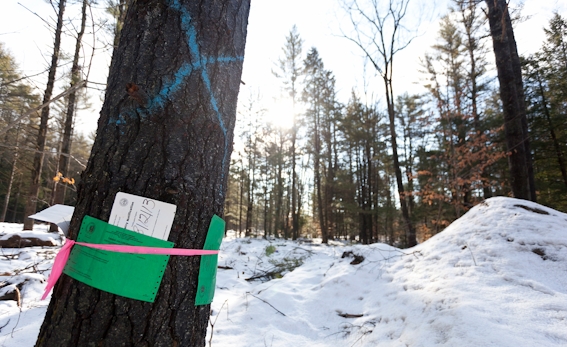New England Forestry Foundation (NEFF) practices Exemplary Forestry on its more than 150 Community Forests, which makes a step-by-step description of our process an easy way to learn about how forest management actually works. Refer to our Exemplary Forestry Resources page for a glossary of forestry terms.
Although NEFF has a number of foresters on staff, we still work almost exclusively with consulting foresters to handle our forest management plans and on-the-ground management activities. Working with these local professionals produces the best results both ecologically and economically, and it removes the burden on staff to administer each step of the process.
A consulting forester is a private forester, not affiliated with a mill or government agency, that helps a landowner meet their objectives for the land and the forest. Using their knowledge of silviculture, wildlife habitat, and harvesting operations, a consulting forester can recommend a course of action to best meet a landowner’s goals.
Before Exemplary Forestry can be practiced, its standards need to be tailored to an individual forest parcel and integrated into a forest management plan. NEFF staff works with consulting foresters to develop management plans for each forest we own, and the plans outline how to best achieve NEFF’s specific goals for these forests.
To create a management plan for NEFF, a consulting forester will first conduct a thorough assessment of our property by inspecting and inventorying features like standing timber volume, rare wildlife species, special habitat types, riparian zones, soils, and land use history. In keeping with Exemplary Forestry’s landscape-scale approach, they will also look at the habitat types available on surrounding properties, and consider if NEFF’s property is well suited to fill any of the habitat gaps within the local landscape.
Once these qualities have been evaluated, the forester will recommend property-specific management activities that accomplish NEFF’s long-term Exemplary Forestry goals of maximizing carbon sequestration, providing habitat for the full range of native wildlife, and producing more climate-smart timber products to support the local economy and meet society’s needs. Exemplary Forestry also accounts for overall forest health and other factors like in-forest recreational opportunities that can be reflected in management recommendations.
The recommended management activities on a given property can vary widely. Examples include:
These plans are updated about every 10 years, which provides us an opportunity to reevaluate our goals regularly, and to keep up with advances in forestry and ecology.
Once a management plan is complete, NEFF implements its recommended actions to accomplish our goals. While those actions vary, as the above list demonstrates, this section will walk through the implementation of a recommended harvest, as that is the type of forest management NEFF staff most often receive questions about.
Depending upon NEFF’s goals for a forestland, harvests are conducted on each property every 10 to 20 years. For each harvest, NEFF staff collaborates with the consulting forester on the goals, strategy, and timing of the harvest. In some states, an Intent to Cut must be posted at the harvest. In other states, such as Massachusetts, a Forest Cutting Plan must be submitted to and approved by the state prior to the start of any work. Once these details are in place, NEFF’s forester can complete the details of the harvest and identify a logger to do the work.
Consulting foresters individually mark each tree to be harvested, or they may outline an area to be harvested if multiple smaller trees are to be taken. Typically, they make these determinations by gauging the location, health, size and anticipated longevity of each tree they evaluate. Generally, these factors help determine which trees are best candidates for removal, though more complex factors are also considered. During marking, a forester will also identify any unique trees to retain after the harvest, such as snags, unique species, or large legacy trees.
In addition, foresters mark the landing, anticipated skid trails (trails machinery will use for tree removal), and potential on-site wetland or stream crossings according to each state’s Best Management Practices (BMPs). These BMPs protect soil and water quality during a timber harvest, and provide guidance on how best to cross streams, buffer around water bodies, and minimize erosion.

Once a harvest is marked and laid out, we will negotiate with a trusted logging contractor or put a sale out to bid, and then sign a contract. The loggers are tasked with removing only the trees the forester has identified. The decisions as to which trees to remove are not made indiscriminately, and they are not at the discretion of the loggers. It is the responsibility of the forester to check in on the sale regularly to ensure the logger is harvesting the correct trees, following the BMPs, and abiding by the terms in the contract. At the end of the job, the forester also ensures the operation is closed out correctly by installing waterbars, cleaning the log landing, and removing any temporary stream crossings. If there are any issues during this process, NEFF’s forester works to resolve them to be sure that everything is held to the highest standard.